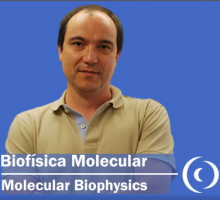Tavares, P., N. Ravi, J. J. Moura, J. LeGall, Y. H. Huang, B. R. Crouse, M. K. Johnson, BH HUYNH, and I. Moura. "
{Spectroscopic properties of desulfoferrodoxin from Desulfovibrio desulfuricans (ATCC 27774).}."
Journal Of Biochemistry. 269 (1994): 10504-10510.
AbstractDesulfoferrodoxin, a non-heme iron protein, was purified previously from extracts of Desulfovibrio desulfuricans (ATCC 27774) (Moura, I., Tavares, P., Moura, J. J. G., Ravi, N., Huynh, B. H., Liu, M.-Y., and LeGall, J. (1990) J. Biol. Chem. 265, 21596-21602). The as-isolated protein displays a pink color (pink form) and contains two mononuclear iron sites in different oxidation states: a ferric site (center I) with a distorted tetrahedral sulfur coordination similar to that found in desulforedoxin from Desulfovibrio gigas and a ferrous site (center II) octahedrally coordinated with predominantly nitrogen/oxygen-containing ligands. A new form of desulfoferrodoxin which displays a gray color (gray form) has now been purified. Optical, electron paramagnetic resonance (EPR), and Mössbauer data of the gray desulfoferrodoxin indicate that both iron centers are in the high-spin ferric states. In addition to the EPR signals originating from center I at g = 7.7, 5.7, 4.1, and 1.8, the gray form of desulfoferrodoxin exhibits a signal at g = 4.3 and a shoulder at g = 9.6, indicating a high-spin ferric state with E/D approximately 1/3 for the oxidized center II. Redox titrations of the gray form of the protein monitored by optical spectroscopy indicate midpoint potentials of +4 +/- 10 and +240 +/- 10 mV for centers I and II, respectively. Mössbauer spectra of the gray form of the protein are consistent with the EPR finding that both centers are high-spin ferric and can be analyzed in terms of the EPR-determined spin Hamiltonian parameters. The Mössbauer parameters for both the ferric and ferrous forms of center II are indicative of a mononuclear high spin iron site with octahedral coordination and predominantly nitrogen/oxygen-containing ligands. Resonance Raman studies confirm the structural similarity of center I and the distorted tetrahedral FeS4 center in desulforedoxin and provide evidence for one or two cysteinyl-S ligands for center II. On the basis of the resonance Raman results, the 635 nm absorption band that is responsible for the gray color of the oxidized protein is assigned to a cysteinyl-S–>Fe(III) charge transfer transition localized on center II. The novel properties and possible function of center II are discussed in relation to those of mononuclear iron centers in other enzymes.

 ]
]